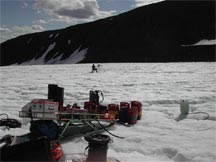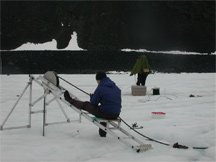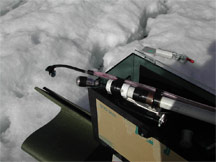Methods

Over three field seasons (2001-2003) we examined the physical and hydraulic characteristics of englacial water flow. We used hot water drilling techniques to drill in four locations, each with a grid of 3 by 3 holes 10 m apart, and in three other locations with three holes in a triangular plan, each ~20 m apart. All holes were located in the upper ablation zone of the glacier (see figure below). Each hole was drilled to the first efficient englacial hydraulic connection, at which point drilling was ceased, or until the bed was encountered. This drilling strategy is different than most others. Most glacier hydrology research projects pursue drilling to the bottom of the glacier to study the hydraulic dynamics at the glacier bed. In our case, we wanted to observe englacial hydraulic characteristics without any influence from the hydraulic regime characteristic at the bed. Most of our holes connected englacially, and in only a few cases did we drill completely to the bed without connecting to a englacial drainage passage. Once a connection was made we lowered a camera to log the hole and image the structure at the point of drainage, including its geometry, size and orientation. Tracers were injected (ink, dye, teflon spheres) to track fluid motion. In some holes, after the visual analysis was complete, we installed pressure transducers to record changes in water pressure.
Finding Englacial Drainage Connections
Fully understanding our approach to finding englacial drainage connections requires an understanding of hot water drilling into a glacier. Water is pumped from a nearby pool of meltwater through a hot water heater. The water is heated to approximately 75° centigrade and continues through an extensive network of plastic hose. The plastic hose terminates at a 2-meter long steel tube at the end of which is a narrow brass nozzle. The narrow opening pressurizes the water so that it emerges with a significant amount of force – like a mini version of a fire hose. The combination of hot and pressurized water melts a hole through the glacier. The heaviness of the steel tube at the end of the hose takes advantage of gravity to help make a straight vertical hole into the glacier.
While drilling, water is pumped into a deepening hole. In addition, the melting ice is generating more water. All this water fills and overtops the hole, so there is typically a small stream of water that flows out of a hole that is being drilled.

The black cylindrical object on the sled is an on-demand water heater. It uses diesel-fueled flames to heat coils through which water passes. Water is being pumped from a surface stream just off the picture to the right where it is sent through the water heater, and then continues out of the heater via a plastic hose and to the drilling stem. The drilling stem in this picture extends into a hole that is being drilled by the person seated in the background of the picture. The hose that extends out to the stem is not visible in this photo because it has melted its way slightly into the glacier.

Drilling is tedious. Someone needs to slowly feed the hose into the hole that is continually melted by the pressurized jet of hot water at the drill stem. Drilling rates range from 1 meter to 2 meters of ice per minute. It would take up to 3 hours to drill a 100-meter deep hole, which was a typical depth for the boreholes that were drilled. In the background is a person extending an underwater camera into a recently drilled hole to inspect the englacial drainage connection that was found by drilling.
Things become exciting for us when, while drilling, the water stops flowing out of the hole, and disappears down the hole and into the glacier. This means that we have connected with some type of internal void. In some instances the void is not connected to a larger network of drainage passages. Drilling water eventually refills the borehole and begins streaming from the top of the hole again. However, in other instances the drilling water never refills the borehole. In this case it is inferred that an englacial drainage passage has been tapped. For this hole, there will be no more drilling and what follows is a study of the feature that caused the water to vanish permanently from the top of the hole and into the glacier.
Studying Englacial Drainage Connections
There were 3 main tools that were used to study the englacial drainage connections. One of the tools was ice radar. That instrument was employed by a team from St. Olaf College and you are referred to their website at www.stolaf.edu/other/cegsic/ to learn about the results of their experiments at Storglaciären. Another tool employed was an underwater video camera. With this system a submersible camera was attached to the end of a 200-meter long triaxial cable.
 The triaxial cable terminated to a hand held digital video camera. A 12-volt battery was used to power a ring of LEDs that illuminated the field of view for the submersible camera. Two of the three wires that comprised the ‘tri’-axial cable were used to deliver this electrical power from the battery at the top of the hole to the submersible camera located deep within the borehole. The images gathered by the submersible camera were viewed and recorded by the digital video recorder operated at the top of the hole. Measurements of the geometry, orientation, and dimensions were made of the englacial drainage features. In addition we attempted to measure water flow within the englacial drainage features. This was accomplished by observing and measuring the lateral movement of sediment particles that were resident in the water. We also performed experiments by introducing tracers such as dye, ink, and glass micro spheres that were neutrally buoyant to water at the opening of the englacial connection.
The triaxial cable terminated to a hand held digital video camera. A 12-volt battery was used to power a ring of LEDs that illuminated the field of view for the submersible camera. Two of the three wires that comprised the ‘tri’-axial cable were used to deliver this electrical power from the battery at the top of the hole to the submersible camera located deep within the borehole. The images gathered by the submersible camera were viewed and recorded by the digital video recorder operated at the top of the hole. Measurements of the geometry, orientation, and dimensions were made of the englacial drainage features. In addition we attempted to measure water flow within the englacial drainage features. This was accomplished by observing and measuring the lateral movement of sediment particles that were resident in the water. We also performed experiments by introducing tracers such as dye, ink, and glass micro spheres that were neutrally buoyant to water at the opening of the englacial connection.

The submersible camera included an attached compass that extended in front of the camera to measure the orientation of the drainage feature, attached fishing line that extended to the top of the hole that allowed the camera to be tilted up for views into the drainage features, and attached tygon tubing that extended to the top of the hole for introduction of dye or glass microspheres at the opening of the drainage feature to observe water flow within the englacial drainage connection.
The third way we studied englacial drainage connections was by measuring their hydraulic characteristics. This was done by installing pressure transducers into a number of holes after the video imaging had been completed. When placed at a fixed depth in water, a pressure transducer records the ‘weight’ of the overlying water column. Water levels in temperate glaciers vary dramatically during the summer months primarily due to the daily fluctuations of meltwater input. Pressure transducers provide a simple way to track these daily rises and falls of the water column within a borehole.